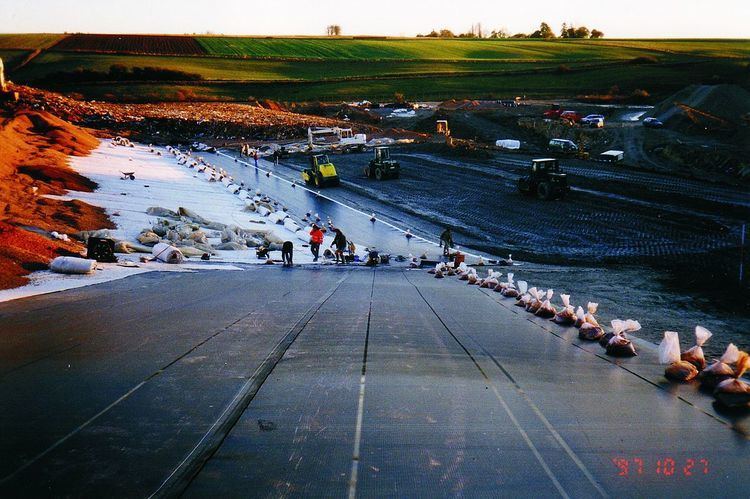 | ||
A geomembrane is very low permeability synthetic membrane liner or barrier used with any geotechnical engineering related material so as to control fluid (or gas) migration in a human-made project, structure, or system. Geomembranes are made from relatively thin continuous polymeric sheets, but they can also be made from the impregnation of geotextiles with asphalt, elastomer or polymer sprays, or as multilayered bitumen geocomposites. Continuous polymer sheet geomembranes are, by far, the most common.
Contents
Manufacturing
The manufacturing of geomembranes begins with the production of the raw materials, which include the polymer resin, and various additives such as antioxidants, plasticizers, fillers, carbon black, and lubricants (as a processing aid). These raw materials (i.e., the "formulation") are then processed into sheets of various widths and thickness by extrusion, calendering, and/or spread coating.
Geomembranes dominate the sales of geosynthetic products, at 1.8 billion USD per year worldwide, which is 35% of the market. The US market is currently divided between HDPE, LLDPE, fPP, PVC, CSPE-R, EPDM-R and others (such as EIA-R), and can be summarized as follows: (Note that M m2 refers to millions of square meters.)
The above represents approximately $1.8 billion in worldwide sales. Projections for future geomembrane usage are strongly dependent on the application and geographical location. Landfill liners and covers in North America and Europe will probably see modest growth (~ 5%), while in other parts of the world growth could be dramatic (10–15%). Perhaps the greatest increases will be seen in the containment of coal ash and heap leach mining for precious metal capture.
Properties
The majority of generic geomembrane test methods that are referenced worldwide are by the ASTM International|American Society of Testing and Materials (ASTM) due to their long history in this activity. More recent are test method developed by the International Organization for Standardization (ISO). Lastly, the Geosynthetic Research Institute (GRI) has developed test methods that are only for test methods not addressed by ASTM or ISO. Of course, individual countries and manufacturers often have specific (and sometimes) proprietary test methods.
Physical properties
The main physical properties of geomembranes in the as-manufactured state are:
Mechanical properties
There are a number of mechanical tests that have been developed to determine the strength of polymeric sheet materials. Many have been adopted for use in evaluating geomembranes. They represent both quality control and design, i.e., index versus performance tests.
Endurance
Any phenomenon that causes polymeric chain scission, bond breaking, additive depletion, or extraction within the geomembrane must be considered as compromising to its long-term performance. There are a number of potential concerns in this regard. While each is material-specific, the general behavior trend is to cause the geomembrane to become brittle in its stress-strain behavior over time. There are several mechanical properties to track in monitoring such long term degradation: the decrease in elongation at failure, the increase in modulus of elasticity, the increase (then decrease) in stress at failure (i.e., strength), and the general loss of ductility. Obviously, many of the physical and mechanical properties could be used to monitor the polymeric degradation process.
Lifetime
Geomembranes degrade slowly enough that their lifetime behavior is as yet uncharted. Thus, accelerated testing, either by high stress, elevated temperatures and/or aggressive liquids, is the only way to determine how the material will behave long-term. Lifetime prediction methods use the following means of interpreting the data:
Seaming
The fundamental mechanism of seaming polymeric geomembrane sheets together is to temporarily reorganize the polymer structure (by melting or softening) of the two opposing surfaces to be joined in a controlled manner that, after the application of pressure, results in the two sheets being bonded together. This reorganization results from an input of energy that originates from either thermal or chemical processes. These processes may involve the addition of additional polymer in the area to be bonded.
Ideally, seaming two geomembrane sheets should result in no net loss of tensile strength across the two sheets, and the joined sheets should perform as one single geomembrane sheet. However, due to stress concentrations resulting from the seam geometry, current seaming techniques may result in minor tensile strength and/or elongation loss relative to the parent sheet. The characteristics of the seamed area are a function of the type of geomembrane and the seaming technique used.
Applications
Geomembranes have been used in the following environmental, geotechnical, hydraulic, transportation, and private development applications:
